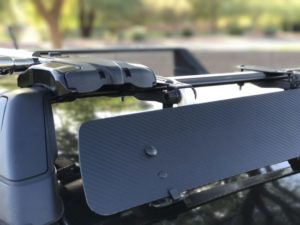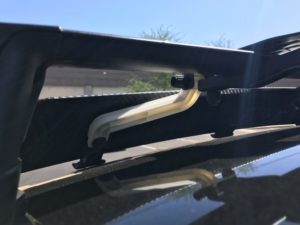 Bicycles are great to have – they’re fun, they’re good exercise, and they’re an eco-friendly way to travel. If you’re planning to take a bike somewhere far away, though, you’d better have a way to mount it on your car, because they don’t typically fit on the inside of most cars. Nathan Huber of Phoenix Analysis & Design Technologies (PADT) bought a set of roof crossbars for his Subaru so that he could mount bikes or skis on the top, and quickly realized that he needed to add a fairing to reduce drag and wind noise. That was fine, but he quickly ran into a problem: when he tried to install a bike rack, he noticed that the fairing mount was in the way of mounting at the tower.
Bicycles are great to have – they’re fun, they’re good exercise, and they’re an eco-friendly way to travel. If you’re planning to take a bike somewhere far away, though, you’d better have a way to mount it on your car, because they don’t typically fit on the inside of most cars. Nathan Huber of Phoenix Analysis & Design Technologies (PADT) bought a set of roof crossbars for his Subaru so that he could mount bikes or skis on the top, and quickly realized that he needed to add a fairing to reduce drag and wind noise. That was fine, but he quickly ran into a problem: when he tried to install a bike rack, he noticed that the fairing mount was in the way of mounting at the tower.
As a result, Huber had to mount the rack inboard of the tower by a few inches, which caused a few issues. The bike was slightly harder to load and unload, and the additional distance from the tower caused the crossbars to flex and the bike to move. Also, when two racks were installed, there was additional interference between bikes.
Luckily, Huber had access to PADT’s technological resources. He needed the fairing mount to be inboard a few more inches, so he and the PADT team started by scanning the left fairing mount bracket with a ZEISS Comet L3D Scanner, coating the bracket in talcum powder to make it easier to scan. They then imported the scan file into ANSYS SpaceClaim to use as a template for an editable CAD file.
“The standard mounting bracket is an injection molded part and is hollow with the exception of a couple of ribs,” said Huber. “I made sure to capture all this geometry to carry forward into my redesigned parts, which would make the move to scaled manufacturing of this design easy.”
Huber used SpaceClaim, a direct modeling software, to split the bracket’s two function ends, the crossbar end and fairing end, and offset them by 4.5 inches so that the bike rack could be mounted right at the crossbar tower.
“I used the geometry from the center section CAD to create my offset structure,” he continued. “A mirrored version allows both the driver and passenger side fairing mount to be moved inboard to enable mounting of two bike racks in optimal positions.”
 Huber turned the CAD file back into STL format for 3D printing, and consulted the PADT team for advice on what technology and material would be best for 3D printing the brackets. They decided to go with selective laser sintering (SLS), using the company’s in-house SINTERSTATION 2500 PLUS from 3D Systems with a glass-filled nylon material.
Huber turned the CAD file back into STL format for 3D printing, and consulted the PADT team for advice on what technology and material would be best for 3D printing the brackets. They decided to go with selective laser sintering (SLS), using the company’s in-house SINTERSTATION 2500 PLUS from 3D Systems with a glass-filled nylon material.
The results were everything that Huber had hoped for. The new fairing mount offset brackets installed just like the factory pieces did, but allowed Huber to install the bike rack right at the tower, eliminating the extra movement and allowing for easier loading and unloading of bikes.
“I am very happy with the end result,” he said. “The new parts assembled perfectly, just as the factory pieces did, and I have increased the functionality of my vehicle yet again.”
If you have a bike rack you’d like to improve, you can find Huber’s files on GrabCAD.
Discuss this and other 3D printing topics at 3DPrintBoard.com, or share your thoughts below.
[Source/Images: PADT]
Subscribe to Our Email Newsletter
Stay up-to-date on all the latest news from the 3D printing industry and receive information and offers from third party vendors.
You May Also Like
3D Printing Unpeeled: Biofuel Waste to Filament & Sustainable Photopolymers
I can’t ever remember a day with so many potentially high impact news stories have come out. In one story, we all know that there are problems with the safety...
Finnair Hires AM Craft to 3D Print Plastic Parts for Aircraft Interiors
Riga-based AM Craft, a supplier specialized in 3D printing aviation components and certified under EASA Part 21G, announced a significant achievement today. The company will assist in upgrading Finnair’s A320...
3DPOD Episode 198: High Speed Sintering with Neil Hopkinson, VP of AM at Stratasys
Neil Hopkinson, a pioneering 3D printing researcher, played a pivotal role in developing a body of research that is widely utilized today. He also invented High Speed Sintering (HSS), also...
3D Printing Webinar and Event Roundup: May 12, 2024
Webinars and events are picking up in the AM industry this week! ASTM International continues its Professional Certificate Course and Stratasys continues its advanced in-person trainings, while 3D Systems is...



































